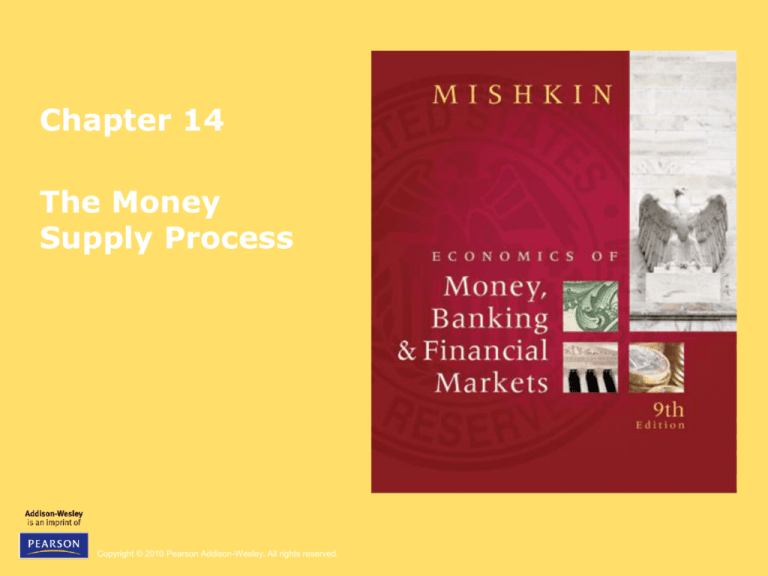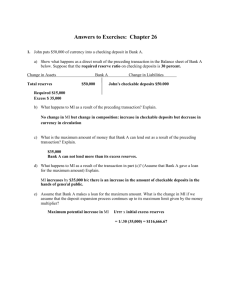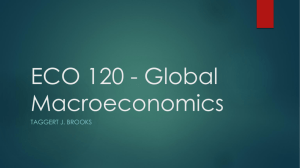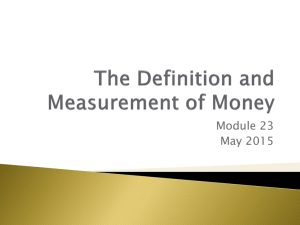
Chapter 14
The Money
Supply Process
Copyright © 2010 Pearson Addison-Wesley. All rights reserved.
Four Players in the Money
Supply Process
1. The central bank—the government agency that
oversees the banking system and is responsible for
the conduct of monetary policy.
2. Banks: commercial banks, savings and loan
associations, mutual savings banks, and credit
unions.
3. Depositors:individuals and institutions that hold
deposits in banks.
4. Borrowers: individuals and institutions that borrow
from the depository institutions and institutions that
issue bonds that are purchased by the depository
institutions.
Copyright © 2010 Pearson Addison-Wesley. All rights reserved.
14-2
Four Players in the Money
Supply Process
• Of the four players, the central Bank (CB) is the
most important. The CB conduct of monetary policy
involves actions that affect its balance sheet
(holdings of assets and liabilities), to which we turn
now.
Copyright © 2010 Pearson Addison-Wesley. All rights reserved.
14-3
CB’s Balance Sheet
Federal Reserve System
Assets
Liabilities
Government securities
Currency in circulation
Discount loans
Reserves
• LIABILITIES
• The sum of the CB monetary liabilities; currency in
circulation (C) and reserves (R) is called the
monetary base (MB).
• 1. Currency in circulation is the amount of currency
in the hands of the (non-bank) public. Currency
held by depository institutions is also a liability of
the Fed, but is counted as part of the reserves.
14-4
Copyright © 2010 Pearson Addison-Wesley. All rights reserved.
CB’s Balance Sheet
• 2. Reserves. consist of deposits at the CB plus
currency that is physically held by banks (vault cash).
• Reserves are assets for the banks but liabilities for
the CB.
• Total reserves can be divided into two categories:
reserves that the CB requires banks to hold
(required reserves) and any additional reserves the
banks choose to hold (excess reserves).
Copyright © 2010 Pearson Addison-Wesley. All rights reserved.
14-5
CB’s Balance Sheet
• ASSETS
• 1. Government securities. The CB provides
reserves to the banking system by purchasing
securities. An increase in government securities
held by the CB leads to an increase in the money
supply.
• 2. Discount loans. The CB can provide reserves to
the banking system by making discount loans to
banks. An increase in discount loans can also be the
source of an increase in the money supply.
Copyright © 2010 Pearson Addison-Wesley. All rights reserved.
14-6
Control of the Monetary Base
• The monetary base (high-powered money) equals
currency in circulation C plus the total reserves in
banking system R. The monetary base MB can be
expressed as:
MB = C + R
• The CB exercises control over the monetary base
through open market operations, and its extension
of discount loans to banks.
Copyright © 2010 Pearson Addison-Wesley. All rights reserved.
14-7
Open Market Purchase from a
Bank
• Suppose that the CB purchases $100 of bonds from
a bank and pays for them with a $100 check.
1. Net result is that reserves have increased by $100
2. No change in currency
3. Monetary base has risen by $100
Banking System
Assets
Liabilities
Securities
-$100
Reserves
+$100
Copyright © 2010 Pearson Addison-Wesley. All rights reserved.
Federal Reserve System
Assets
Securities
Liabilities
+$100 Reserves
+$100
14-8
Open Market Purchase from
Nonbank Public I
• We must look at two cases. First, let’s assume that
the person or corporation sells $100 of bonds to the
CB deposits the check in a local bank.
1. Net result is that reserves have increased by $100
2. No change in currency
3. Monetary base has risen by $100
Banking System
Assets
Reserves
Federal Reserve System
Liabilities
+$100 Checkable
deposits
Copyright © 2010 Pearson Addison-Wesley. All rights reserved.
+$100
Assets
Securities
Liabilities
+$100 Reserves
+$100
14-9
Open Market Purchase from
Nonbank Public II
• Second, the person selling the bonds cashes the CB
check either at a local bank or at the CB for currency
1. Reserves are unchanged
2. Currency in circulation increases by the $100
3. Monetary base increases by the amount of the $100
Nonbank Public
Assets
Liabilities
Securities
-$100
Currency
+$100
Copyright © 2010 Pearson Addison-Wesley. All rights reserved.
Federal Reserve System
Assets
Securities
Liabilities
+$100 Currency in
circulation
+$100
14-10
Open Market Purchase:
Summary
• If the proceeds from the sale are kept in currency,
the OMO purchase has no effect on reserves;
• if the proceeds are kept as deposits, reserves
increase by the amount of the OMO purchase.
• The effect of an OMO purchase on the MB, however,
is always the same (the MB increases by the
amount of the purchase) whether the seller of the
bonds keeps the proceeds in deposits or in
currency.
• The impact of an OMO purchase on reserves is
much more uncertain than its impact on the MB.
Copyright © 2010 Pearson Addison-Wesley. All rights reserved.
14-11
Open Market Sale
• if the CB sells $100 bonds to an individual who pays
for them with currency,
1. Reduces the monetary base by the amount of the sale
2. Reserves remain unchanged
3. The effect of open market operations on the monetary base
is much more certain than the effect on reserves
Nonbank Public
Assets
Liabilities
Securities
+$100
Currency
-$100
Copyright © 2010 Pearson Addison-Wesley. All rights reserved.
Federal Reserve System
Assets
Securities
Liabilities
-$100 Currency in
circulation
-$100
14-12
Shifts from Deposits into
Currency
• suppose that a person decides to close her account
by withdrawing her $100 balance in cash and vows
never to deposit it in a bank again.
– The banking system loses $100 of deposits and hence $100
of reserves.
– the monetary base is unaffected by the person’s disgust at
the banking system.
Copyright © 2010 Pearson Addison-Wesley. All rights reserved.
14-13
Shifts from Deposits into
Currency
Nonbank Public
Assets
Banking System
Liabilities
Checkable
deposits
-$100
Currency
+$100
Assets
Reserves
Liabilities
-$100 Checkable
deposits
-$100
Federal Reserve System
Assets
Copyright © 2010 Pearson Addison-Wesley. All rights reserved.
Liabilities
Currency in circulation
+$100
Reserves
-$100
14-14
Making a Discount Loan to a
Bank
• When the CB makes a $100 discount loan to the First
National Bank, the bank is credited with $100 of
reserves from the proceeds of the loan.
1. Monetary liabilities of the Fed have increased by $100
2. Monetary base also increases by this amount
Banking System
Assets
Reserves
Federal Reserve System
Liabilities
+$100 Discount
loans
+$100
(borrowing from Fed)
Copyright © 2010 Pearson Addison-Wesley. All rights reserved.
Assets
Discount
loan
Liabilities
+$100 Reserves
+$100
(borrowing from Fed)
14-15
Paying Off a Discount Loan from
the Fed
• if the bank pays off the loan from the CB, thereby
reducing its borrowings from the CB by $100,
– Net effect on monetary base is a reduction
– Monetary base changes one-for-one with a change in the
borrowings from the Federal Reserve System
Banking System
Assets
Reserves
Federal Reserve System
Liabilities
-$100 Discount
loans
-$100
(borrowing from Fed)
Copyright © 2010 Pearson Addison-Wesley. All rights reserved.
Assets
Discount
loans
Liabilities
-$100 Reserves
-$100
(borrowing from Fed)
14-16
Other Factors Affecting the
Monetary Base
1. Float. When the Fed clears checks for banks, it
often credits the amount of the check to a bank
that has deposited it (increases the bank’s
reserves) but only later debits (decreases the
reserves of) the bank on which the check is drawn.
The resulting temporary net increase in the total
amount of reserves in the banking system (and
hence in the monetary base) occurring from the
Fed’s check-clearing process is called float
Copyright © 2010 Pearson Addison-Wesley. All rights reserved.
14-17
Other Factors Affecting the
Monetary Base
2. Treasury deposits at the Federal Reserve.
When the Treasury moves deposits from
commercial banks to its account at the CB, leading
to a rise in Treasury deposits at the CB, it causes a
deposit outflow at these banks thus causes
reserves in the banking system and the monetary
base to fall.
3. Interventions in the foreign exchange market
also affects the monetary base.
Copyright © 2010 Pearson Addison-Wesley. All rights reserved.
14-18
Other Factors Affecting the
Monetary Base
2. Treasury deposits at the Federal Reserve.
When the Treasury moves deposits from
commercial banks to its account at the CB, leading
to a rise in Treasury deposits at the CB, it causes a
deposit outflow at these banks thus causes
reserves in the banking system and the monetary
base to fall.
3. Interventions in the foreign exchange market
also affects the monetary base.
Copyright © 2010 Pearson Addison-Wesley. All rights reserved.
14-19
Deposit Creation: Single Bank
– Suppose that the First National Banks gives a $100
loan to a borrower who deposited the loan in Bank A.
– If the RRR=10, the bank can only give loans of the
excess reserves $90.
– If the borrower puts the loan in Bank B, this bank will
only be able to give loans of the excess reserves $81,
which will be deposited in another bank, and so on.
– The checkable deposits would increase so far by the
total amount of $271 ($100 + $90 + $81).
– If all banks make loans for the full amount of their
– excess reserves, further increments in checkable
deposits will continue as depicted in Table.
Copyright © 2010 Pearson Addison-Wesley. All rights reserved.
14-20
Deposit Creation:
The Banking System
Bank A
Assets
Reserves
Bank A
Liabilities
+$100 Checkable
deposits
Assets
+$100 Reserves
Loans
Reserves
+$10 Checkable
deposits
+$100
+$90
Bank B
Assets
Liabilities
Bank B
Liabilities
+$90 Checkable
deposits
Assets
+$90 Reserves
Loans
Copyright © 2010 Pearson Addison-Wesley. All rights reserved.
Liabilities
+$9 Checkable
deposits
+$90
+$81
14-21
Table 1 Creation of Deposits (assuming
10% reserve requirement and a $100
increase in reserves)
Copyright © 2010 Pearson Addison-Wesley. All rights reserved.
14-22
Deposit Creation: the banking
system
• The multiple increase in deposits generated from an
increase in the banking system’s reserves is called
the simple deposit multiplier. More generally, the
simple deposit multiplier equals the reciprocal of the
required reserve ratio, so the formula for the
multiple expansion of deposits can be written as:
∆D = (1 / r) × ∆R
– where ∆D = change in total checkable deposits in the
banking system
– r = required reserve ratio (0.10 in the example)
– ∆R = change in reserves for the banking system ($100 in
the example)7
Copyright © 2010 Pearson Addison-Wesley. All rights reserved.
14-23
Critique of the Simple Model
• The actual creation of deposits is much less
mechanical than the simple model indicates.
Holding cash stops the process
– Currency has no multiple deposit expansion
• Another situation ignored is the one in which banks
do not make loans or buy securities in the full
amount of their excess reserves. If banks choose to
hold all or some of their excess reserves, the full
expansion of deposits predicted by the simple model
of multiple deposit creation does not occur.
Copyright © 2010 Pearson Addison-Wesley. All rights reserved.
14-24
Critique of the Simple Model
• The CB is not the only player whose behavior
influences the level of deposits and therefore the
money supply. Depositors’ decisions (how much
currency to hold) and bank’s decisions (amount of
excess reserves to hold) also cause the money
supply to change.
Copyright © 2010 Pearson Addison-Wesley. All rights reserved.
14-25
The Money Multiplier
• Because the CB can control the monetary base
better than it can control reserves, it makes sense
to link the money supply M to the monetary base
MB through a relationship such as the following:
M = m × MB
(1)
• The variable m is the money multiplier, which tells
us how much the money supply changes for a given
change in the monetary base MB.
Copyright © 2010 Pearson Addison-Wesley. All rights reserved.
14-26
The Money Multiplier
• The money multiplier reflects the effect on the
money supply of other factors besides the monetary
base.
• Depositors’ decisions about their holdings of
currency and checkable deposits are one set of
factors affecting the money multiplier.
• It also involves the reserve requirements imposed
by the CB on the banking system.
• Banks’ decisions about excess reserves also affect
the money multiplier
Copyright © 2010 Pearson Addison-Wesley. All rights reserved.
14-27
Deriving the Money Multiplier
• Assumptions:
• assume that the desired level of currency C and
excess reserves ER grows proportionally with
checkable deposits D; in other words, we assume
that the ratios of these items to checkable deposits
are constants in equilibrium:
• c = {C/D} = currency ratio
• e = {ER/D} = excess reserves ratio
Copyright © 2010 Pearson Addison-Wesley. All rights reserved.
14-28
Deriving the Money Multiplier
• We begin the derivation of the model of the money
supply with the equation:
R = RR + ER
Where RR=required reserves and ER=excess reserves.
• The total amount of required reserves equals the
required reserve ratio r times the amount of
checkable deposits D:
RR = r × D
Copyright © 2010 Pearson Addison-Wesley. All rights reserved.
14-29
Deriving the Money Multiplier
• Substituting r × D for RR in the first equation yields
an equation that links reserves in the banking
system to the amount of checkable deposits and
excess reserves they can support:
R = (r × D) + ER
• Because the monetary base MB equals C plus R, we
can generate an equation that links the amount of
monetary base to the levels of checkable deposits
and currency by adding currency to both sides of the
equation:
MB = R + C = (r × D) + ER + C
Copyright © 2010 Pearson Addison-Wesley. All rights reserved.
14-30
Deriving the Money Multiplier
• To derive the money multiplier formula in terms of
the currency ratio c = {C/D} and the excess
reserves ratio e = {ER/D}, we rewrite the last
equation, specifying C as c × D and ER as e × D:
MB = (r × D) + (e × D) + (c × D)
= (r + e + c) × D
• We next divide both sides by the term inside the
parentheses to get an expression linking checkable
deposits D to the monetary base MB:
D = (1 / r + e + c) × MB
(2)
Copyright © 2010 Pearson Addison-Wesley. All rights reserved.
14-31
Deriving the Money Multiplier
• Using the definition of the money supply as currency
plus checkable deposits (M = D + C) and again
specifying C as c × D,
• M = D + (c × D) = (1 + c) × D
• Substituting in this equation the expression for D
from Equation 2, we have:
M = ((1 + c) / (r + e + c)) × MB
(3)
The money multiplier m is thus:
M = (1 + c) / (r + e + c)
(4)
Copyright © 2010 Pearson Addison-Wesley. All rights reserved.
14-32
Intuition Behind the Money Multiplier
•
•
•
•
•
•
Given the following information
r = required reserve ratio = 0.10
C = currency in circulation = $400 billion
D = checkable deposits = $800 billion
ER = excess reserves = $0.8 billion
M = money supply (M1) = C + D = $1,200 billion
• From these numbers we can calculate the values for
the currency ratio c and the excess reserves ratio e:
Copyright © 2010 Pearson Addison-Wesley. All rights reserved.
14-33
Intuition Behind the Money Multiplier
• c = $400 billion / $800 billion = 0.5
• e = $0.8 billion / $800 billion = 0.001
• The resulting value of the money multiplier is:
m = (1 + 0.5) / (0.1 + 0.001 + 0.5)
= 1.5 / 0.601 = 2.5
• The money multiplier of 2.5 tells us that, a $1
increase in the monetary base leads to a $2.50
increase in the money supply (M1).
• Note that although there is multiple expansion of
deposits, there is no such expansion for currency.
Copyright © 2010 Pearson Addison-Wesley. All rights reserved.
14-34
Money Supply Responses to Changes
in the Factors
• Changes is r. If r increases banks must contract their
loans, causing a decline in deposits and hence in the
money supply. The reduced money supply relative to
MB, indicates that the money multiplier has declined
as well.
• when r increases from 10% to 15%, m becomes:
• m = (1 + 0.5)/(0.15 + 0.001 + 0.5) = 2.3
• The money multiplier and the money supply are
negatively related to the required reserve ratio r.
Copyright © 2010 Pearson Addison-Wesley. All rights reserved.
14-35
Money Supply Responses to Changes
in the Factors
• Changes in c. what happens to m when depositor
behavior causes c to increase?
• When checkable deposits are being converted into
currency, there is a switch from a component of the
money supply that undergoes multiple expansion to
one that does not.
• Suppose that c rises from 0.50 to 0.75. The money
multiplier then falls from 2.5 to:
• m = (1 + 0.75)/(0.1 + 0.001 + 0.75) = 2.06
• The money multiplier and the money supply are
negatively related to the currency ratio c.
Copyright © 2010 Pearson Addison-Wesley. All rights reserved.
14-36
Money Supply Responses to Changes
in the Factors
• Changes in e. When banks increase their holdings of
excess reserves relative to checkable deposits, banks
will contract their loans, causing a decline in the level
of checkable deposits and a decline in the money
supply, and the money multiplier will fall.
• Suppose that e rises from 0.001 to 0.005.
• m = (1 + 0.5)/(0.1 + 0.005 + 0.5) = 2.48
• The money multiplier and the money supply are
negatively related to the excess reserves ratio e.
Copyright © 2010 Pearson Addison-Wesley. All rights reserved.
14-37
The M2 Money Multiplier
• The derivation of a money multiplier for the M2
definition of money requires only slight modifications
to the analysis in the chapter. The definition of M2
is:
• M2 = C + D + T
• where
• T = time and savings deposits (t.D)
• We assume that t = T/D,
• M2 = D + (c × D) + (t × D)
= (1 + c + t) × D
Copyright © 2010 Pearson Addison-Wesley. All rights reserved.
14-38
Money Supply Responses to Changes
in the Factors
• Substituting in the expression for D from Equation 2
in the chapter,1 we have
• M2 = ((1 + c + t)/(r + e + c)) × MB
• Suppose that t = 3
• m2 = (1 + 0.5 + 3)/(0.10 + 0.001 + 0.5) = 7.5
Copyright © 2010 Pearson Addison-Wesley. All rights reserved.
14-39









